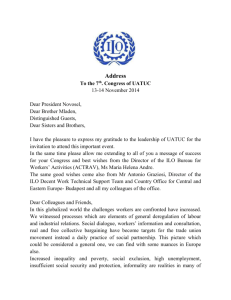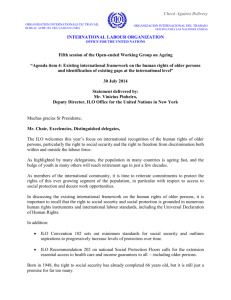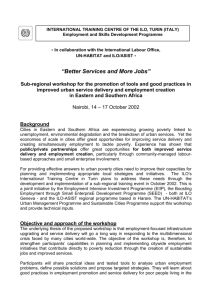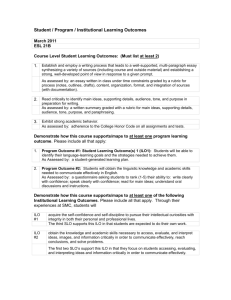Child labor in the New Economy of Asia
advertisement
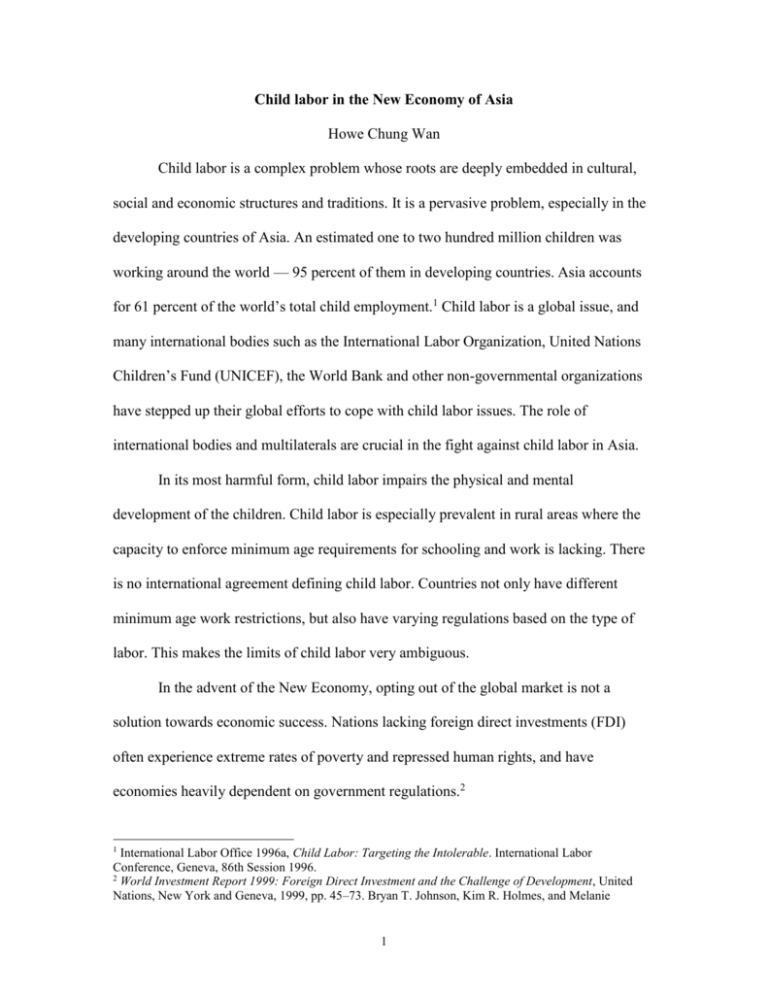
Child labor in the New Economy of Asia Howe Chung Wan Child labor is a complex problem whose roots are deeply embedded in cultural, social and economic structures and traditions. It is a pervasive problem, especially in the developing countries of Asia. An estimated one to two hundred million children was working around the world — 95 percent of them in developing countries. Asia accounts for 61 percent of the world’s total child employment.1 Child labor is a global issue, and many international bodies such as the International Labor Organization, United Nations Children’s Fund (UNICEF), the World Bank and other non-governmental organizations have stepped up their global efforts to cope with child labor issues. The role of international bodies and multilaterals are crucial in the fight against child labor in Asia. In its most harmful form, child labor impairs the physical and mental development of the children. Child labor is especially prevalent in rural areas where the capacity to enforce minimum age requirements for schooling and work is lacking. There is no international agreement defining child labor. Countries not only have different minimum age work restrictions, but also have varying regulations based on the type of labor. This makes the limits of child labor very ambiguous. In the advent of the New Economy, opting out of the global market is not a solution towards economic success. Nations lacking foreign direct investments (FDI) often experience extreme rates of poverty and repressed human rights, and have economies heavily dependent on government regulations.2 1 International Labor Office 1996a, Child Labor: Targeting the Intolerable. International Labor Conference, Geneva, 86th Session 1996. 2 World Investment Report 1999: Foreign Direct Investment and the Challenge of Development, United Nations, New York and Geneva, 1999, pp. 45–73. Bryan T. Johnson, Kim R. Holmes, and Melanie 1 One of the most important reasons in the use of child labor was poverty in families, forcing children to serve as primary household earners. The reduction of income poverty occurs with growth in average living standards.3 Developing nations need help to build the capabilities that will enable them to become part of the new world. The rate of children working decreases as per capita GDP of the country rises.4 This paper serves to examine the importance of multilaterals and the world economy to reduce child labor globally. Attributes and reasons for child labor are discussed in detail to explore how the new economy can play a part to resolve child labor issues. In particular, the paper analyzes the flow of capital and foreign direct investments into specific developing nations in Asia. The purpose is to address the links and relationships between the global economy, foreign direct investments, poverty and standard of living with respect to child labor. Real world examples are drawn from Asia since Asia accounts for most of the world’s child labor. Child labor statistics Child labor force participation rates are much higher in rural than in urban areas, and three-quarters of working children work in the family enterprise. Child workers in export industries (such as textile, clothing, carpets, and footwear) are relatively few compared with those employed in activities geared to domestic consumption. Probably Kirkpatrick, 1999 Index of Economic Freedom, The Heritage Foundation and Wall Street Journal, 1999, pp. xix-xxviii. 3 Aaron, Carl, The Contribution of FDI to Poverty Alleviation, Foreign Investment Advisory Service (FIAS) 4 World Development Report 1999/2000, Child Labor: How much? How damaging? And what can be done? Oxford University Press, Inc. New York, September 2000, p. 62 2 less than five percent of child laborers are employed in the export manufacturing or mining sectors, and only one to two percent are employed in export-oriented agriculture.5 In a survey conducted on six countries by the International Program on the Elimination of Child Labor (IPEC which is headed by ILO), the incidence of child labor was found to decline with per capita GDP. The labor force participation rate of children aged 10-14 years is extremely high at thirty to sixty percent in countries with per capita income of $500 or less (at 1987 prices). But it declines quite rapidly to ten to thirty percent in countries with incomes between $500 and $1,000. Also child labor seemed to be related to the structure of production. The higher the share of agriculture in GDP, the higher the incidences of child labor.6 According to the ILO, the term "child labor" generally refers to any economic activity performed by a person under the age of 15. Not all work performed by children is detrimental or exploitative. Child labor does not usually refer to "light work" after school or legitimate apprenticeship opportunities for young people. Nor does it refer to young people helping out in the family business or on the family farm. Rather, the "child labor" of concern is employment that prevents effective school attendance, and which is often performed under conditions hazardous to the physical and mental health of the child. According to the World Education Report 1998 and Demographic Yearbook 1995, and as reported by Directorate of Adult, slightly less than one third of World’s illiterate aged 15 years and above are in India — 46 percent of India’s population aged 15 years and above 5 International Labor Office 1996a, Child Labor: Targeting the Intolerable, International Labor Conference, Geneva, 86th Session 1996. 6 Peter Fallon and ZafirisTzannatos, Child Labor: Issues and Directions for the World Bank. http://wbln0018.worldbank.org/HDNet/HDdocs.nsf/f879b8f845ed3915852566500051f549/e4bcc001dba99 537852566b1000a86fa?OpenDocument. 3 are illiterate.7 Dropout rates have decreased significantly from 1960 to 1997, however, dropout rates at elementary stages for children up to 14 years of age are still about 55 percent in 1997.8 The Indian national survey sponsored by the CBCI (Commission on Justice, Development and Peace) included 6,997 domestic workers who were interviewed in 12 towns/cities and 12 districts of 8 states in India. Child domestic workers comprise one sixth of this unorganized sector. Karnataka State has the highest percentage (30.48 percent) of child labor. Calcutta, Kerala and Ranchi seem to be more sensitive to the child labor laws and have the lowest percentage — about 16 percent of domestic workers below the age of 18 years. According to an ILO report, 13 million child workers were estimated to be in India in 2000. The ILO estimates that for the world as a whole, 68 million children aged less than 15 years were working in 2000. India's share in child labor works out to be about twenty percent.9 But the ILO study points out that the various figures of child labor may be an underestimation since in some countries, young workers less than 15 years of age are not included in labor force statistics.10 In other countries, young workers both work and go to school and are rarely considered as being part of the labor force. Again the statistics cover only those youngsters who have a fixed job and thus exclude the majority of those who work only occasionally. Dr Irwanto, Professor of Child Psychology at the Catholic University of Indonesia, provided evidence that the ILO research on child labor statistics was incomplete, because ILO obtained information from 7 Directorate of Adult World, Education Report 1998 and Demographic Yearbook 1995, United Nations, New York. 8 Web site of the Ministry of Education – Elementary Education, Department of Education, Government of India. http://www.education.nic.in/htmlweb/edusta.htm 9 Bureau of Statistics, International Labor Organization, Economic Active Population Volume I, Asia, STAT Working Papers, (1950 – 2010), Geneva, 1996, p.78. 4 a few departments in the Ministry of Labor (Indonesia) rather than surveying the general public in the country.11 It is impossible to make an accurate estimate of the numbers employed, for the simple reason that, in most countries child labor is clandestine, it is in the interest of all parties concerned to conceal it. There is no reason to doubt that ILO survey suffers from the same limitations. Government policies and child labor laws The total number of ‘economically active’ children in Nepal is estimated to be at 2.7 million according to a survey by the Centraal Bureau voor de Statistiek (CBS) of Netherlands.12 This is approximately 60 percent of Nepal’s population between the ages of eight and sixteen years. In an interview I conducted with Sumnima Tuladhar, a Program Officer with the Child Workers in Nepal Resource and Information Center, I asked him about the reasons why child labor was still a major problem in Nepal and whether it was due to cultural practices or globalization. He stated that, “ Poor political commitment, ineffective implementation of laws and lack of systematic monitoring and follow-up of existing laws… are some of the immediate factors of the child labor problem.”13 The Nepali government has taken some initiatives to fight the child labor problem. The Ministry of Labor has signed the Memorandum of Understanding with international bodies such as the ILO (IPEC) and UNICEF. These commitments are reflected in the provisions made by the 1990 Constitution of Nepal, the 1991 Labor Act, and the Children’s Act of 1992. The government also ratified the UN Convention on the 10 Child Domestics Survey in India: Summary of a national survey sponsored by the CBCI, Commission on Justice, Development and Peace. http://www.cwa.tnet.co.th/domestic/pages27-29.htm 11 Protection of children in the Indonesian Constitution, Kompas, 10 March 2000. 5 Rights of Children and the ILO Convention 138 of Minimum Age. The 1990 Constitution includes provisions to help protect the rights of children, especially with regards to slavery, human trafficking, serfdom and forced child labor. Progress on child labor issues is evident in Indonesia, especially with the ratification of ILO Convention 182 on protection of child labor. Indonesia was the first country in Asia to have ratified the convention into their constitution.14 However, a report from one of the national newspapers of Indonesia, Kompas on 2nd June 2000, revealed that ratification of ILO Convention 182 was ‘performed’ for the sake of international politics.15 The Director of the National Commission of Child Protection, Arist Merdeka Sirait, felt that President Abdurrahman Wahid could involve the police and military in enforcing the laws regarding child labor issues. He believed that eradication of child labor was not about politics but required a system that involved many aspects of the government and formulating strategies together. The Commission, he felt, should have the legal powers to directly give aid to children in families in financial crisis, or even relocate children from families with domestic violence or evidence of abuse. Article 24 of the Indian constitution clearly stated “No child below the age of fourteen years shall be employed to work in any factory or mine or employed in any hazardous employment.” 16 Article 39(e) directed state policy such “that the health and strength of workers . . . and the tender age of children are not abused and that citizens are 12 Bijaya Sainju, Child Labor in Nepal: Realities and Challenges. http://www.cwa.tnet.co.th/booklet/Nepal.htm 13 Sumnima Tuladhar, email to Howe Chung Wan on October 04, 2000. 14 ILO Office in Jakarta, The Ratification of Convention No. 182 of the ILO. http://www.ilo.org/public/english/region/asro/jakarta/conv182.htm 15 Kompas, 2nd June 2000. http://www.kompas.com 16 Constitution of India cited in Jain, S. N. Legislation and Government Policy in Child Labour, In Child Labour and Health: Problems & Prospects, edited by U. Naidu and K. Kapadia. Bombay: Tata Institute of Social Sciences, 1985, p. 218. http://www.geocities.com/CollegePark/Library/9175/inquiry1.htm 6 not forced by economic necessity to enter avocations unsuited to their age or strength.”17 In August 1994, the former Prime Minister Narasimha Rao announced his proposal of an Elimination of Child Labour Programme. This program aimed to end child labour for two million children in hazardous industries as defined in the Child Labour Act of 1986, by the year 2000.18 Indeed, all of the policies that the Indian government has in place are in accordance with the Constitution of India, and all support the eradication of child labor. However, as in Nepal and Indonesia, enforcement of these policies was a major problem in the government’s efforts and hence child labor still existed. In 1996, the Human Rights Watch reported the government efforts in India, “A glaring sign of neglect of their duties by officials charged with enforcing child labor laws is the failure to collect, maintain, and disseminate accurate statistics regarding enforcement efforts.”19 Reasons for child labor and societal attitudes In general, the principal reason why children work is poverty. Though child workers are not well paid, their contribution to family income (sometimes as much as 20 – 33 percent) can be essential to its survival.20 In general, children are paid much less than the prevailing minimum wage and are not organized in trade unions. According to a report by the ILO in 1991, the continuing demand for cheap labor, fuelled by growing 17 Constitution of India cited in Human Rights Watch, The Small Hands of Slavery - Bonded Child Labor in India, New York: Human Rights Watch, 1996, p. 28. 18 Human Rights Watch, The Small Hands of Slavery - Bonded Child Labor in India. New York: Human Rights Watch, 1996, pp. 119-120. 19 Ibid, p. 131. 20 Child Labor, The Nature of the Problem: Some Basic Facts, Unicef Programs on Child Protection. http://www.unicef.org/programme/cprotection/labour.htm. Syed, K.A., A. Mirza, R. Sultana and I. Rana. Child Labor: Socioeconomic Consequences. "Pakistan and Gulf Economist 1991, 10: 36-39. Unicef claims child labor contribution amounts to 25 percent, while Syed et al maintains that child labor contribution to family income comes up to 33 percent. 7 competition in the global market, further aggravates the child labor problem.21 Employers recruit children (at an average age of ten) because the children are controllable, disorganized, accept lower wages and accept flexibility of tasks and longer working hours.22 School attendance by a child is also highly correlated with family income.23 Therefore, when children drop out of school to work, it is not necessarily because of irresponsible parenting; it may be due to the family's financial situation. Sumnima Tuladhar described the reasons for child labor in Nepal, “… underlying factors are … the inequitable distribution of land; poor access to resources and production, … gender inequity; lack of people centered and sustainable development programs and environmental degradation … thus causing family disintegration. Widespread illiteracy, ignorance of parents about child rights, … growing adult unemployment and lack of alternatives for survival in the rural areas are other immediate factors of child labor problem.”24 In 1998, the adult illiteracy rate (as a percentage of 15 and above) in Nepal was 43 percent for males and 78 for females.25 A report by Child Workers in Asia noted that child marriages and polygamy were still practiced in Nepal. Therefore, family separation and desertion happen quite often, resulting in children running away from home. Concerning environmental aspects, 84 percent of Nepal’s population do not have access to sanitation, and 29 percent do not have access to safe 21 Sinclair, V. and G. Trah, Child Labor: National Legislation on the Minimum Age for Admission to Employment or Work, in Conditions of Work Digest. (International Labor Office, Geneva) 1991, 10,1:19146. 22 Kekebew Ashagrie, Methodological Child Labor Surveys and Statistics: ILO’s Recent Work in Brief, http://www.ilo.org/public/english/bureau/stat/child/childlab/htm June 1997 23 Ilon, L. and P. Moock. School Attributes, Household Characteristics and Demand for Schooling: A Case Study of Rural Peru, 1991, International Review of Education 37,4: 429-452. 24 Sumnima Tuladhar, email to Howe Chung Wan on October 04, 2000 25 World Development Report 2000/2001, Attacking Poverty, Table 2. Quality of Life, p.277. 8 water.26 Unemployment of parents further aggravated the problem of child labor. Education in Nepal is not compulsory; therefore parents could not be forced to send their children to schools.27 From December 18th 2000 to January 5th 2001, I visited Kathmandu Valley and the Langtang region north of Kathmandu. In villages of altitudes of approximately 2500m and below such as in Dhumche, Syabru or Helambu region, elementary schools for children up to 12 years of age were set up. However, in areas with altitudes of 3000m and above, where the settlements were vastly spread out, like in Langtang and Gosaikunda, children helped out in the farms and in village hotels, instead of going to school. Hence, in mountainous and less economically developed regions of Nepal, inaccessibility and distance were some reasons why children did not receive formal education. A teacher I interviewed revealed that the Nepali government provides for the building of school facilities, but school uniforms, textbooks and food during school had to be provided by families. Therefore, only parents who knew the importance of education would send their children to schools. Rapid rural to urban migration is another cause of child labor. Families in the rural areas leave for employment opportunities in the urban areas that often do not exist. In 1950, 17 percent of the population of the developing world lived in urban areas. By the year 2000 it is estimated that this proportion will increase to forty percent, and to 57 percent by the year 2025.28 Such drastic migrations into the urban areas led to family problems such as parents deserting their families, forcing children into early employment. 26 United Nations, Human Development Report 2000, Human Development Index, Human Poverty in developing countries, p.170. 27 Bijaya Sainju, Child Labor in Nepal: Realities and Challenges. http://www.cwa.tnet.co.th/booklet/Nepal.htm 28 United Nations, Revisions, Global Estimates and Projections of Population by Age and Sex, New York 1989. 9 Education problems also contribute to child labor. A survey by the ILO in 1992 found out reasons cited by children who never attended school or those who dropped out of school. The reasons included financial problems (e.g., forty percent of the dropouts in one of the surveys gave this factor as a reason), need for participation in household economic activities or in household chores, costs of schooling, distance to schools poor school facilities and fear of teachers. The failure of schools to provide rewarding, quality education to meet the needs of children contributes to the dropout rate and hence to the growth of the child labor market. However, the survey showed that if the children had a choice, a very high proportion of those who did not want to continue to work preferred to pursue schooling.29 Children are often influenced into work by their parents. According to a study, parents represent 62 percent of the source of induction into child employment. Children make their own decisions to work only 8 percent of the time.30 Parents who find no use in their children attending school will prefer to teach their children skills to supplement the family income. Parents considered that their child’s work was very important in supplementing the family income. Parental influence and obligation plays a large role in determining child schooling and employment.31 India has the largest juvenile workforce because 82 million children are not in school. This means that only a minority gets a quality education. For example, only 54 percent of Indians over the age of 15 are Kekebew Ashagrie, Methodological Child Labor Surveys and Statistics: ILO’s Recent Work in Brief. June 1997. http://www.ilo.org/public/english/bureau/stat/child/childlab/htm 30 Syed, K.A., A. Mirza, R. Sultana and I. Rana. Child Labor: Socioeconomic Consequences. "Pakistan and Gulf Economist 1991, 10: 36-39. 31 Tienda, M. Economic Activity of Children in Peru: Labor Force Behavior in Rural and Urban Context, 1979 Rural Sociology 44: pp. 370-391. 29 10 literate.32 This decreases to 33 percent in Bangladesh and 26 percent in Pakistan.33 In developing countries, parents may have children because they can contribute economically. In fact, children contribute more economically and are less of an economic burden in developing countries than their counterparts in developed nations.34 Nonetheless, the cause of child labor is not always related to poverty. Research conducted by the Action Aid Nepal in the Sindhuli district revealed that school aged children from wealthy families were sent to work in carpet factories in Kathmandu.35 Cultural factors also play a role. A tradition of beginning one’s working life in childhood, without the benefit of schooling, is passed on from one generation to the next, perpetuating a cycle of poverty and illiteracy. For example in India, people of the lower castes are expected to perform manual labor and therefore not suitable to attend school. This kind of social separation perpetuates child labor. Cultural beliefs that educated women will not get married and have children restrict women from gaining access to education and promote child labor.36 So called scheduled caste children such as the Kami, Dam, Pode and Sakri in Nepal are often not encouraged to go to school with other children.37 Even in a developed country such as the United States, in Pennsylvania, under Amish tradition, youngsters worked in apprenticeship settings after the eight after eight grade. For years that didn’t conflict with federal law because the livelihood of the Amish 32 Directorate of Adult World, Education Report 1998 and Demographic Yearbook 1995, United Nations, New York. 33 Weiner, M. The Child and the State in India. Princeton, New Jersey: Princeton University Press. 1991. 34 Lindert, P. Child Costs and Economic Development" In R.A. Easterlin, ed., Population and Economic Change in Developing Countries, 3. . The University of Chicago Press, Chicago, 1976. 35 Bijaya Sainju, Child Labor in Nepal: Realities and Challenges. http://www.cwa.tnet.co.th/booklet/Nepal.htm 36 Bequele, A. and J. Boyden. Working Children: Current Trends and Policy Responses, International Labor Review 1988 127, 2: pp. 153 – 171. 37 Bijaya Sainju, Child Labor in Nepal: Realities and Challenges. http://www.cwa.tnet.co.th/booklet/Nepal.htm 11 was rooted in agriculture and farms are exempt from child-labor laws. 38 But with growing costs of farming, many families had turned to woodworking and other small trades. Federal labor laws prohibit children younger than 16 from working in manufacturing operations and children younger than 18 from working in other hazardous occupations. Child labor in the New Economy Globalization has economic, political and cultural dimensions, all of which can have a social impact. Economic globalization can be simply defined as a process of rapid economic integration among countries. It has been driven by the increasing liberalization of international trade, and by freer capital flows. The process manifests itself mainly through an intensification of activities in the following areas: international trade in goods and services; capital flows (FDI and portfolio); the role of multinational enterprises (MNE); the reorganization of production networks on an international scale and the adoption of new technologies, including information technology.39 Foreign direct investment (FDI) involves a long-term relationship and reflects a lasting interest and control of domestic assets by foreign investors. Theoretical considerations and empirical evidence suggest that globalization has the potential to increase peoples' welfare. Most cross-country studies conclude that increased trade and foreign direct investment flows are, at least in the long run and in most cases, correlated with higher rates of economic growth and productivity increases for the economy as a 38 The Christian Science Monitor, Amish seek exemption from federal ban on child labor, December 4, 2000. http://www.csmonitor.com/durable/2000/12/04/p5s1.htm 12 whole.40 In a study by the Foreign Investment Advisory Service, the relationship between FDI and (income) poverty reduction can be broken into two elements — the relationship between FDI and (income) growth on one hand and that between growth and poverty reduction on the other. It was generally found that inflows of FDI encourage more rapid economic growth. Sumnima Tuladhar believes that the reasons for the existence of child labor in Nepal were: In Nepal, the problem of child labor is due to existing unfair and exploitative labor relations, socio-economic and political structure of the society and a very big gap between the rich and poor. In Nepal the direct effect of globalization in this regard is yet to be experience but of course, the current trend of globalization is a key cause of so many problems including the widening gap between rich and poor, north and south. 41 The role of the world economy and globalization in the developing countries, especially those with the problems of poverty is becoming a pertinent issue in defining the roles of the poorer nations in the world economy. Senator Tom Harkin introduced the US Child Labor Deterrence Bill in 1992. According to a report by the American Federation of Labor - Congress of Industrial Organizations (AFL-CIO): The Senate unanimously passed the International Labor Organization (ILO) Convention on the 182 Elimination of the Worst Forms of Child Labor. The Convention was approved in Geneva by ILO member states on June 17, 1999… the Senate overwhelming approved (96-0) a Harkin amendment to the Africa Trade Bill which would deny trade benefits to countries that did not meet or effectively enforce the standards in ILO Convention 182 for the Elimination of the Worst Forms of Child Labor.42 There has been considerable international discussion on the controversial issue of core labor standards and international trade. This is largely due to the linkage that is made 39 International Labor Organization, Working Party on the Social Dimensions of the Liberalization of International Trade, Country studies on the social impact of globalization: Final report, 276th Session, Geneva, November 1999. 40 Ibid. 41 Sumnima Tuladhar, email to Howe Chung Wan on October 04, 2000. 13 in some quarters between access to industrialized country markets by developing countries and their observance of minimum labor standards. Many citizens and governments in industrialized countries feel that developing countries benefit from unfair competition when they export goods and services without meeting minimum labor standards. In the developing world, on the other hand, many feel that linking trade and labor standards is done for protectionist purposes. It is not that those in the developing world are opposed to labor standards; rather, they believe that establishing a direct link between labor standards and trade is simply an excuse to restrict the flow of goods and services from developing to developed countries. In the recent ILO Declaration on Fundamental Principles and Rights at Work, child labor was deemed detrimental to development, since it means that the next generation of workers will be unskilled and less well educated. In today's increasingly globalized economy, this has especially negative consequences, since, as pointed out in the present report, a skilled and educated labor force is critical to economic development, increasing incomes and social progress. Anti-globalists argued that global corporations ignore abuses of human rights, such as employing child labor. The United Nations estimated that tens of millions of children were trafficked around the world as bonded labor or sex slaves; hundreds of thousands of children are forcibly recruited as soldiers in armed conflict.43 In China, companies often confiscated young workers’ identification cards to prevent them from leaving and seeking employment elsewhere. 42 Statement of Senator Tom Harkin (D-IA), Senate passes ILO Child Labor Convention, Website of U.S. Senator Tom Harkins of Iowa, http://www.senate.gov/%7Eharkin/releases/99/11/1999B05B18.html. 43 Barbara Crossette, Clinton Signs Agreement To Help Protect Children, New York Times, July 6, 2000, A11. 14 As a matter of fact, empirical evidence from a World Bank research paper demonstrated no relationship between labor standards and export performance or FDI.44 Therefore, an influx of FDI does not have any effect on the core labor standards of developing countries. A very small percentage of child labor is involved in the formal sectors of industries that are directly related to foreign investments. Global economy’s link to child labor The incidence of child labor has been falling on a global basis, but there are different trends across regions. The proportion of children who work has been declining in Southeast Asia given rising per capita incomes, the spread of basic education, and a reduction in family size but dropping at a slower rate in many countries in Africa. World : Child labor rates (age 10 - 14) 45 Activity rates (%) 40 35 30 World 25 Asia 20 Africa 15 South America 10 5 0 1940 1950 1960 1970 1980 1990 2000 2010 2020 Year Figure 1. Child Labor Rates in the World (1940 – 2020). (Appendix A) 44 Maskus, Keith E., Should Core Labor Standards be imposed through International Trade Policy? The World Bank Development Research Group, August 1997, pp. 14–22. http://www.worldbank.org/research/trade/pdf/wp1817.pdf 15 Asia : Child labor rates (age 10 - 14) 45 Activity rates (%) 40 35 30 Eastern Asia 25 South Central Asia 20 South-eastern Asia 15 Western Asia 10 5 0 1940 1960 1980 2000 2020 Year Figure 2. Child Labor Rates in Asia (1940 – 2020). (Appendix A) But generally, there is a notable decrease in the activity rates of child (ages 10 – 14) throughout the world. The greatest decrease in child labor rates was observed in Asia while the decrease was significantly smaller in Africa. (Figure 1.) In Asia particularly, the decrease in child labor rates was apparent, with Eastern Asia having the fastest decrease in child economic activity. Child labor was estimated to disappear in Eastern Asia totally before 2010. (Figure 2.) There are clear decreasing trends in child labor activity in South Asia as well, except the decrease much less steep. FDI did have a positive impact on reducing child labor as seen in Figure 3. Regions with lower levels of FDI per population as in Sub-Saharan Africa had a significantly high level of child labor rates, while inversely, Latin America and East Asia enjoyed higher levels of FDI per population, together with lower rates of child labor activity. 16 35 160 30 140 120 25 5 100 80 60 40 20 0 0 20 15 10 FDI/Population Child labor rates(%) Histogram of child labor rates and FDI/Population Child labor rates FDI/Population SubSouth AsiaEast Asia & Latin Saharan Pacific America & Africa Carribean Regions Figure 3. Histogram of child labor rates versus foreign direct investment/population. (Appendix B) From Figure 4, higher GNP per capita was correlated with lower child labor rates. Developing countries with open economies grew by an average of 4.5 percent per year in the 1970s and 1980s, while those with closed economies grew just 0.7 percent a year. The fastest developing region of the world —East Asia — witnessed growth in real per capita income at an annual average rate of 4 to 6 percent since the 1960s. In China, by the year 2001, per capita GDP had nearly quadrupled since 1980, lifting an estimated 160 million people from absolute poverty. From 1972 to 2001, the poverty rate in Indonesia has been more than cut in half. 45 Per capita GDP (in 1997 U.S. dollars) rose from $163 in 1980 to $235 in 1997 in the least developed countries — a 44 percent increase.46 45 Aaron Lukas, WTO Report Card III: Globalization and Developing Countries (Washington, D.C.: Cato Institute, June 2000), 2, 4. 46 Tomas Larsson, Stick to the Facts, Please, Ideas on Liberty, July 2000, 21. 17 Child labor rates(%) 35 4500 4000 3500 3000 2500 2000 1500 1000 500 0 30 25 20 15 10 5 0 GNP per capita Histogram of child labor rates and GNP per capita Child labor rates GNP per capita SubSouth AsiaEast Asia & Latin Saharan Pacific America & Africa Carribean Regions Figure 4. Histogram of child labor rates versus GNP per capita. (Appendix B) Child labor rates, Illiteracy rates (%) Histogram of child labor rates and illiteracy rates 70 60 50 Child labor rates 40 Illiteracy rates-Male 30 Illiteracy rate-Female 20 10 0 SubSaharan Africa South Asia East Asia & Latin Pacific America & Carribean Regions Figure 5. Histogram of child labor rates versus illiteracy rates. (Appendix B) Roles of the multilaterals and international bodies The Bangladesh garment industry provides an interesting experience of the fight against child labor. In order to deal with this situation, the Bangladesh Garment Manufacturers Association (BGMEA) concluded a Memorandum of Understanding 18 (MOU) with the ILO and UNICEF aimed at the elimination of child labor in the garment industry in June 1995. Under the MOU, the three parties agreed to develop and implement an experimental monitoring system to remove child workers under the age of 14 from garment factories and to prevent other children from entering employment in garment factories. As a result, over eight thousand children were successfully removed from eight hundred garment factories and enrolled in special education programs.47 This provides a good example of how child labor can be eliminated from specific export industries without hurting the children who are displaced, although it must be admitted that industry-specific programs do not address the problem of child labor in its entirety.48 An example of the increased role of trade unions in resource mobilization is that of the Italian trade unions, along with ILO and UNICEF social partners, where they led the campaign to raise US$1.8 million. The funds are currently being used by ILO-IPEC and in Nepal, Bangladesh and Pakistan on projects for the elimination of child labor. This private initiative approach has encouraged other international and national trade unions to follow suit. In 1998 the Japanese Trade Union Confederation (JUTC-RENGO) contributed approximately US$ 40,000 to IPEC. Working closely with other partners, government and non-governmental organizations, the trade unions have incorporated the topic of child labor in their worker education programs, and encouraged community integration activities for purposes of better detection and surveillance of child labor incidence. Trade unions have undertaken lobbying at both the national and local IPEC (ILO), Employers’ response to Child Labor: The Bangladesh Garment Manufactures’ Association (BGMEA) http://www.ilo.org/public/english/standards/ipec/about/factsheet/expls-98/exampl1.htm 48 International Labor Organization, Working Party on the Social Dimensions of the Liberalization of International Trade, Country studies on the social impact of globalization: Final report, 276th Session, November 1999. 47 19 government levels for policy reform and improved services for child workers, and intensified its advocacy activities as well.49 Multinational companies contributing to FDI in developing countries are aware of the core labor standards and have made efforts to eliminate child labor violations. For example, the Global Alliance for Workers and Communities is a unique partnership of business, public and non-profit organizations including NIKE, Inc. Gap, Inc. and the World Bank. The Global Alliance aims to provide young adults with global manufacturing ways to improve their lives, workplaces and communities, was launched April 1999. Frequently, manufacturing for global companies is organized through contract factories, owned and operated by entrepreneurs who do not necessarily have cultural or community links to the factory workforce.50 The Global Alliance implemented a Workers and Communities project at Lian Thai Textile Industrial Co. Ltd, Thailand. Their report showed “worker satisfaction with regard to safety at work, and that the workers have a good relationship with management.”51 However, some counter opinions that challenged Global Alliance’s independence from Nike came from the Thai Labour Campaign commissioned by Clean Clothes Campaign. Based on a research conducted by the Thai Labour Campaign into the Nike’s Global Alliance study they uncovered a large gap between the reality at Lien Thai and the portrait the Global Alliance paints. They claimed that the report from Global Alliance was biased and failed to outline the complete context of their findings and the methodology that allowed them to obtain these 49 IPEC (ILO), Workers Taking the Lead in Action Against Child Labor, http://www.ilo.org/public/english/standards/ipec/about/factsheet/expls-98/exampl1.htm 50 NikeBiz.com, Global Alliance Formed to Enhance Workers’ Lives, http://www.nikebiz.com/media/n_enhance.shtml. 51 Junya Yimprasert, Lian Thai Industrial and the Global Alliance for Workers and Communities, September 2000, http://www.cleanclothes.org/companies/nike00-09-15-1.htm 20 results. The Thai Labour Campaign research clearly demonstrated that the Global Alliance initiative was no substitute for an independent monitoring and verification system, or for a genuine complaints mechanism that allows workers to voice their grievances.52 Ways to reduce child labor Several approaches have been suggested to reduce child labor. The approaches are not mutually exclusive and probably work best in combination. Policies aimed at reducing child labor are based on purely economic grounds. Children sent out to work at an early age do not develop the human capital skills to earn higher wages in the future and as adults, they have lower productivity levels which become a burden on the economic growth of their society and country. As noted, poverty is one of the major causes of child labor. Reduction of poverty is a long-term process but programs that improve the labor earnings of the poor, address capital market constraints, and provide safety nets can help reduce child labor in the short term.53 Education represents the most important means of drawing children away from the labor market. Education together with poverty reduction can foster human capital development, with positive economic and social impacts. According to the ILO World Labor Report, low enrollments in schools are correlated with higher rates of child employment.54 Therefore, increasing primary school enrollments tends to decrease child Clean Clothes Campaign, Research into Nike’s Global Alliance Study, http://www.cleanclothes.org/companies/nike00-09-15.htm. 53 Fallon and Tzannatos, Grootaert, Christiaan, and Ravi Kanbur. Child Labor: A Review World, Bank Policy Research Working Paper 1454. Washington, D.C. 1998. http://wbln0018.worldbank.org/HDNet/HDdocs.nsf/f879b8f845ed3915852566500051f549/e4bcc001dba99 537852566b1000a86fa?OpenDocument. 54 ILO (International Labor Office), World Labor Report 1992, Geneva, 1992. 52 21 labor. Making it easier for children to attend work and school simultaneously is a desirable option and seems particularly relevant in rural areas. The school year must be carefully scheduled not to conflict with the peak agricultural season. This principle was applied successfully in Kerala (India) and Vietnam. This can, however, make the school year too short for example, closure of up to two hundred days a year in Kerala. An alternative in rural and urban areas is to run night classes, although it is difficult to target these only for working children. However, complete abolition of child labor is not totally feasible because the relationship between poverty and education is very complicated. Though mandatory basic education is highly desirable on moral grounds, the actual difficulty lies in the enforcement of this strategy. Children are unable to attend these schools unless there is a significant improvement in their economic conditions. Strong enforcement, on the other hand, may threaten the economic welfare of poorer families who heavily depend on the contribution of child labor as a source of income. Compulsory education can protect children from exploitative forms of labor since children have to be released to attend school, but the schedule of school hours must be carefully planned so the children are not overloaded. Many children go to school and work at the same time. Many of them have to work in order to attend school because they could not afford the tuition and high costs associated with attendance. This clearly shows the fact that child labor and education may work together. A study found that only twenty percent of children in India who dropped out engaged in paid employment.55 Therefore, immediate elimination of child labor is not necessarily the solution. 55 Seetharamu, A.S. and U. Devi. Education in Rural Areas: Constraints and Prospects. New Delhi: Ashish Publishing House, 1985. 22 Schools must make it worthwhile for children to attend in order to make up for lost earnings. Reducing costs of education via subsidies, direct payments, and school feeding schemes provide incentives for households to divert child labor into education. Schools can be made free or serve food supplements. In this case, parents may view this nutrition as valuable and let their children go to school. The quality of education should be significantly improved so that education is pertinent for successful careers.56 The costs and sustainability of this intervention should be further explored. On a wider spectrum, public awareness towards child labor can be raised by improving the general awareness of hazards to working children, and raising parental awareness of the loss of human capital associated with child labor. There is a need for more cooperation among the local communities, non-government organizations, and governments to put pressure on employers. Applying pressure on employers alone does not solve the problem of child labor unless alternative income sources for poor families are created. Most nations have laws and regulations governing child labor issues, however, enforcement is often weak and poses a great problem. It is very unlikely that a ban on child labor will be very effective in a very poor country where the labor force possesses little skill. If the wage (adult income) is above the subsistence level, children will not be sent to work, and if the wage is below this subsistence level, then children will have to work to supplement their parents’ income. Hence, for wages below subsistence, the labor supply curve includes children while for wages above subsistence, the labor supply curve 56 Faraaz Siddiqi, Harry Anthony Patrinos, Child labor: Issues, Causes and Interventions, Human Development and Operations Policy, World Bank. http://www.worldbank.org/html/extdr/hnp/hddflash/workp/wp_00056.html 23 excludes child workers, as shown in Figure 6.57 For a relatively low-skilled workforce, represented by the lowest labor demand curve, the economy will be at the lowest point where labor demand curve intersects the effective labor supply curve. In this case, adult wage is low and children will be sent to work. For an economy with a relatively highskilled labor force, represented by the uppermost labor demand curve, the intersection of labor demand and effective labor supply yields a high wage, above subsistence, and families would not send their children to work. In the situation of a medium-skilled labor force represented by the labor demand curve in the middle, labor demand curve intersects the labor supply curve in two places — a higher wage situation where children would not have to work and a lower-wage situation where children would have to work. If a ban on child labor was imposed on a relatively low-skilled economy, the labor supply curve would be one of adults only (left upward-sloping line), adult wage would rise but not enough to be above subsistence. Children will be sent to work to supplement their parents’ income. In such a situation where the law is not compatible with incentives of families, it is likely that an underground market for child labor will emerge and possibilities of poorer working conditions for the children and corruption cases of official who have to enforce the ban. On the other hand, if the reduction in labor force due to the ban drives the adult wage up, families will not send the children to work. In this case, the ban is self-liquidating and can be used to deflect the economy from a bad situation to a better one. Thus it is difficult to know if a ban is feasible in a medium-skilled economy since the consequences of the ban differ so much. 57 Pham Hoang Van, Child Labor in South-East Asia, Cornell University Southeast Asia Outreach Program http://www.einaudi.cornell.edu/SoutheastAsia/outreach/childlabor/labor1.html 24 The imposition of stringent and across-the-board laws may force the children into more dangerous and hidden forms of work since these laws may reduce the incomes of poorer families. Legislation should be more focused on the intolerable forms of child labor such as slavery and working in hazardous conditions. In June 1999, Convention 182 of the International Labor Organization that targets the elimination of the worst forms of child labor was adopted. Non-regulatory means to reduce child labor such as trade sanctions, consumer boycotts, and labeling schemes are controversial. Exports products in the formal sector are worst hit by trade measures, which may force child workers into the informal sector where working conditions are typically worse. Trade sanctions are often a cover for protectionist measures, which may be implemented in discretionary ways that have little to do with child labor.58 Figure 6. Effects of market forces and ban on child labor. 58 World Development Report 1999/200, Child Labor: how much? How damaging? And what can be done? Oxford University Press, New York, September 2000, p. 62. 25 Increased awareness in developed countries of child labor problems in the Third World countries can actually lead to demands for inappropriate action against countries in which child labor is a serious problem without sufficient attention to the consequences for the child workers. Not all child labor is harmful. Children living in a stable environment with their families or under the protection of a guardian can benefit from informal education and job training. Economic research has shown that the use of child labor may actually be a fundamental evolutionary stage in the development of a country. Evidence suggests that parents have children based on a cost-benefit perspective.59 Children in developing countries tend to be of economic value and, as a result, become a desirable asset for struggling parents. Children can significantly contribute to family income. Therefore, child labor is an intrinsic component of survival in a developing country. After a certain level of development is reached, children are more of an economic burden and take on less fiscal importance as contributors. During England's “developing stage”, children's contributions to family income paralleled those of present Peru and Paraguay. But as a country develops, children start to consume more than they produce.60 Therefore, the role of children differs in developed and developing countries. At certain levels of poverty in developing countries, child labor may play an instrumental role in economic survival, which augments national economic development. 59 Singh, R. and G.E. Schuh. The Economic Contribution of Farm Children and the Household Fertility Decisions: Evidence from a Developing Country, Brazil. Indian Journal of Agricultural Economy, 1986, pp. 29–40. 60 Lindert, P. Child Costs and Economic Development. In R.A. Easterlin, ed., Population and Economic Change in Developing Countries, The University of Chicago Press, Chicago, 1976. 26 Conclusion Child labor remains a global issue. Role of multilaterals coupled with the world economy is pertinent in reducing child labor in the world. The influx of FDI and trade is one of the most effective and feasible methods of alleviating poverty and, therefore, reducing child labor. Globalization has been driven by the increasing liberalization of trade and capital flow especially foreign direct investment. Most importantly, the influx of capital does not have any negative impact on the labor standards. Obviously, there is still a child labor problem that is primarily due to cultural reasons and domestic labor policies. Further progress in reducing child labor will take place as education levels improve worldwide and more economic and social mobility occur in developing countries of Asia. 27 Appendix A Activity rates are obtained from the Economic active population Volume I, II, III, IV, V, STAT Working Papers, International Labor Organization, Bureau of Statistics (1950 – 2010). Activity rates represent the percentage of population in the specified age group who are 'economically active'. The "economically active population" comprises all persons of either sex who furnish the supply of labor for the production of economic goods and services as defined by the United Nations systems of national accounts and balances, during a specified time-reference period. According to these systems, the production of economic goods and services includes all production and processing of primary products, whether for the market, for barter or for own consumption, the production of all other goods and services for the market and, in the case of households which produce such goods and services for the market, the corresponding production for own consumption. It includes persons in "paid employment" and those in "self-employment" (such as employers, own-account workers and members of producers' cooperatives, unpaid family workers, persons engaged in the production of economic goods and services for own and household consumption, and apprentices who receive pay) as well as members of the armed forces (including first-time jobseekers). 28 Appendix B Data was obtained from tables from the World Development Report 2000/2001, Attacking Poverty. Definitions Child labor rates as of 1999 (rates of percent age group, 10-14) FDI data as of 1998(in millions of dollars) GNP as of 1999(in millions of dollars) Adult illiteracy rate - percent of people 15 and above (1998) 29
